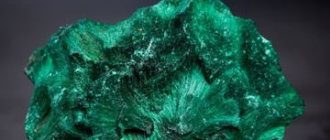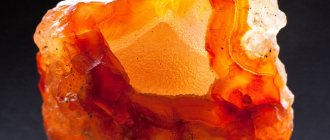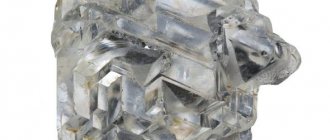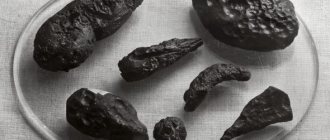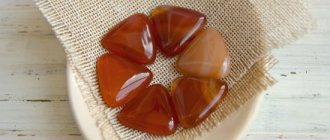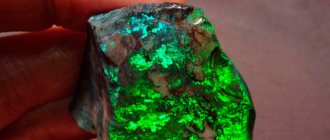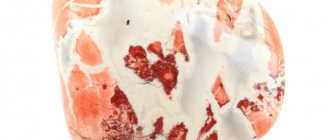Synonyms: Aegirite - aegirite, partially aegirine-augite - aegirine-augite, clinopyroxene, natrosiderite - natrosiderite.
Group
origin of name
Named after the mythological Icelandic god of the sea, Aegir.
Aegirine needle-like secretions Kola Peninsula
Story
The history of the mineral is connected with Northern Europe:
- Deposits of industrial scale have been discovered in Norway.
- The first scientist to become interested in the stone was the great Swedish chemist Baron Jens Jacob Berzelius in 1821. He discovered or coined names for dozens of minerals.
- The stone was christened Aegirin in 1835 by the Dane Jens Esmark.
The mineral is named after Aegir, the god of the seas in German-Scandinavian mythology.
Although for centuries it has appeared as akmite - in the form of sharp-edged crystals.
The term "akmit" is translated from ancient Greek as "edge".
Jewelry with mineral
Many people can afford inexpensive but . To make the stone easy to process, jewelers use the cabochon and tumbling techniques.
The most interesting specimens are used to make rings, earrings and pendants with frames made of precious metals. Opaque minerals are used in costume jewelry . They are used to make relatively cheap beads, bracelets and necklaces.
In addition to decorative value, jewelry is useful to wear for nurses and doctors whose work involves the use of electromagnetic radiation. The stone will protect them from long-term harmful effects. A figurine made from Akmit should be placed next to the computer .
What does the stone look like?
Aegirine is an opaque or translucent mineral with a glassy or metallic luster. The main color is black, dark green, brown, and brown specimens are not uncommon.
More often it is not pure aegirine that is found, but varieties in the form of mixed crystals:
- Aegirinus – Augite.
- Aegirine is a diopside.
- Aegirine is hedenbergite.
When you rotate the stone, the shade looks different. This property is especially pronounced in thin sections.
Crystals are like tetrahedral prisms or needles.
Application of aegirine
One of the areas of application of aegirine is the jewelry industry. Transparent large stones are used to make jewelry-quality jewelry. The crystals are cut into tumbling or cabochons, enriched with precious metals and presented to the consumer in the form of rings, pendants or earrings. Opaque stones of pure aegirine or its formations with other minerals are used to make jewelry - beads, bracelets, pendants and necklaces.
Aegirine in its pure form, as well as crystals intergrown with orthoclase or quartz, are classified as valuable collection stones. Many unique specimens of different structures and sizes are the property of famous private collections and mineralogical museums.
The mineral is endowed with healing energy, therefore it is effectively used in lithotherapy. Balls made from aegirine are not only an unusual souvenir, but also a tool that mediums and magicians use for astral travel.
Aegirine contains rare earth elements, so theoretically it could be in demand in industry for the isolation of, for example, scandium.
Physico-chemical characteristics
Aegirine is a silicate from the pyroxene group. Its composition is complex, which is reflected in the long formula.
| Color | Greenish black |
| Stroke color | Light green |
| Chemical formula | NaFe3+[Si2O6] |
| Shine | glass, metal-shaped |
| Transparency | opaque |
| Cleavage | perfect |
| Hardness | 6 — 6,5 |
| Specific gravity | 3,6—3,4 |
| Selection form | Columnar, needle-shaped |
| Classes on taxonomy of the USSR | Silicates |
| singonia | monoclinic |
| Additionally | Melts easily. Behavior in acids: Slightly soluble. |
Varieties
The color of aegirine depends on the chemical composition and structure of the crystals in each particular stone. Thus, fine-needle aegirine will be light green, yellow-green or colorless, and obelisk-like aegirine will be dark green, black, brown or brown.
Fact! Transparent crystals are very rare.
An interesting feature of aegirine is that if, when examining the stone, it is rotated along different axes, it changes color:
- Ng axis. The color changes from blue to bright blue and light blue.
- Axis Nm. The purple color changes to lavender and blue.
- Axis Np. Colorless, red, dark carmine, orange and pink.
Interesting! When viewed under a microscope, the mineral may appear purple, orange-brown, pink, violet-blue, or dark brown.
This feature is associated with the refraction of light in the many small faces of the crystals that make up the mineral aegirine. And also depending on the proportions of metals in its composition, for example, an excess of manganese adds red-violet shades, and iron – red-brown. But at the same time, all minerals have a glassy sheen and a silky sheen.
Place of Birth
Aegirine is a rock-forming mineral of volcanic (less often hydrothermal) origin.
Distributed throughout the planet, but there are features:
- Industrial-scale deposits are located in the USA, Canada, Nigeria, and Scotland. As well as the two largest islands on the planet - Greenland and Madagascar.
- The largest stones come from Sweden and Norway.
- The world's best crystals come from the East African state of Malawi.
In Russia, the rock is mined in the Urals and the Kola Peninsula.
Use in alternative medicine
The stone is very good at healing the human nervous system.
The mineral is endowed with incredible healing energy, which is why it is actively used in lithotherapy. Aegirine helps cleanse the human body of toxic substances, strengthens the immune system and the central nervous system. The mineral strengthens and makes the largest digestive gland, abdominal organs, and gall bladder work better. Plus, aegirine accelerates the healing of wounds and promotes faster healing of various diseases.
With the help of the stone, it will be possible to strengthen the nerves, musculoskeletal system and relieve debilitating pain in the back and muscles. Since the gem has the strongest healing power, it is often used to combat depression, melancholy and sadness. Aegirine will improve sleep and drive away nightmares, and for this you should place the rock near the bed or under the pillow. You need to wear the stone closer to the place on the body that is bothering you.
Where is it used?
The mineral aegirine is classified as an ornamental mineral. It is processed as a cabochon for earrings, rings, and pendants. More often this is the costume jewelry segment; single samples fall into a higher category.
Aegirine jewelry
Jewelry alloy, nickel silver, and silver are used as a setting.
The main area of application is mineralogical collections.
Stone care
Aegirine has a high degree of fragility, so you need to be careful when using it. You should not drop or throw jewelry made from this mineral. It is best to store it in a soft bag or box. It is worth rinsing under running water without using aggressive chemicals. Such products can damage the structure of the stone and it will lose its natural shine.
How to distinguish
Inexpensive fragile stone is not particularly in demand among jewelers and stone cutters. Therefore, it is rarely counterfeited.
Aegirine is opaque, so the “understudy” is almost always plastic. It's easy to distinguish:
- Lightweight compared to natural mineral.
- Initially warm.
- Heats up quickly in your hands.
Natural aegirine leaves a light green streak on the surface.
Imitation is more likely in talismans, amulets, and esoteric assortments.
Zodiac signs
In the astrological world, aegirine is called the Taurus stone. The mineral helps representatives of this particular sign cope with their inherent stubbornness and inability to compromise. He teaches them prudence, balance, calmness and the ability to “listen” to loved ones. The stone also helps to reveal the abilities of Taurus and find their own position in life.
Aegirine also gives Virgos and Capricorns increased attention. The rest of the zodiac signs can safely use its properties, since the stone is absolutely harmless. Back to contents
5 / 5 ( 2 voices)
Related materials:
Price
You rarely see jewelry with aegirine on the Internet. Collectible samples are better presented (price / rub.):
- nugget (80-83 g, 6x4 cm; Kola Peninsula, Khibiny) – 600-700;
- crystal (1.5x4 cm; Malawi) – 80;
- cabochon (2x4 cm; Khibiny) – 250.
It’s easier to make a talisman yourself or buy a blank cabochon.
Magic properties
The unique magical property of aegirine is to transform negative energy into positive. A person who has such a talisman, even in a hopeless situation, will discover advantages and ways out.
The results will be amazing:
- Desires and plans will begin to come true.
- A person will think clearly, pragmatically, and make optimal decisions.
- Intuition and the work of the subconscious will develop.
- It will be easier to overcome cravings for alcohol, drugs, shopaholism, and other bad addictions.
- The magic of the stone will awaken talents for business, and a career leap is possible.
- Traveling will become easier and safer.
- For yoga adherents, it is important as an attribute of meditation.
The stone is a proven home talisman against quarrels, envy, and invasion of uninvited guests.
Therapeutic effect
Lithotherapists have identified an abundance of positive energy for humans emitted by aegirine:
- It puts a shield against radiation and other harmful substances. Therefore, the stone is ideal for personnel in X-ray rooms and similar industries.
- Helps treat the gastrointestinal tract, genitourinary and circulatory systems.
- The stone is prescribed for nervous disorders, insomnia, anxiety, and mood swings.
Aegirine will bring you out of depression, give you a feeling of confidence, and gently “force” you to love yourself.
The stone enhances the magical and healing effects of other minerals.
Healing properties and astrology
Lithotherapists note the powerful healing properties of the mineral. It has strong energy and even enhances the abilities of other stones. The crystal has a positive effect on the body's immune system, increases its protective functions, cleanses it of harmful substances (toxins, electromagnetic and radiation radiation), and promotes rapid recovery.
Traditional healers use the mineral to treat gastrointestinal pathologies and muscle pain. The stone reduces inflammation in the fallopian tubes. Constantly wearing aegirine helps calm the nervous system. It relieves depression, obsessive negative thoughts, and fights chronic fatigue and apathy. As experts note, the stone is even capable of bringing its owner out of a shock or stressful situation and helps to regain faith in oneself.
In the teachings of Feng Shui, the mineral symbolizes the energy of water. It is recommended to place products made from it in recreational areas. Contemplation of aegirine allows you to organize your thoughts and find answers to all your questions.


